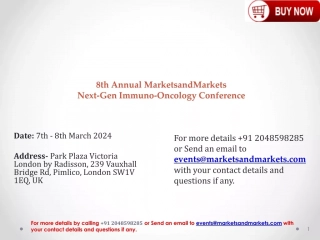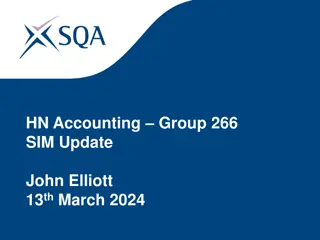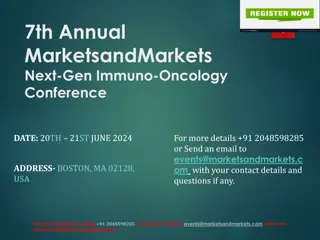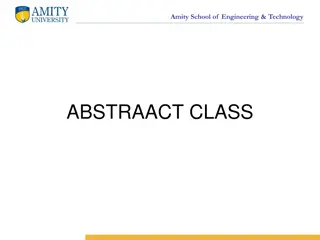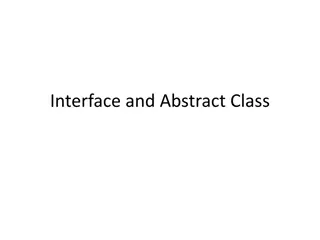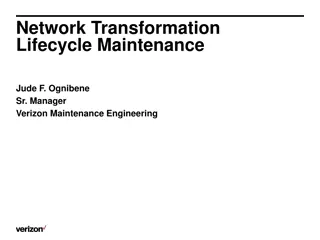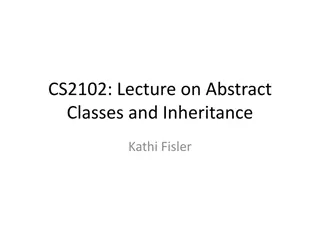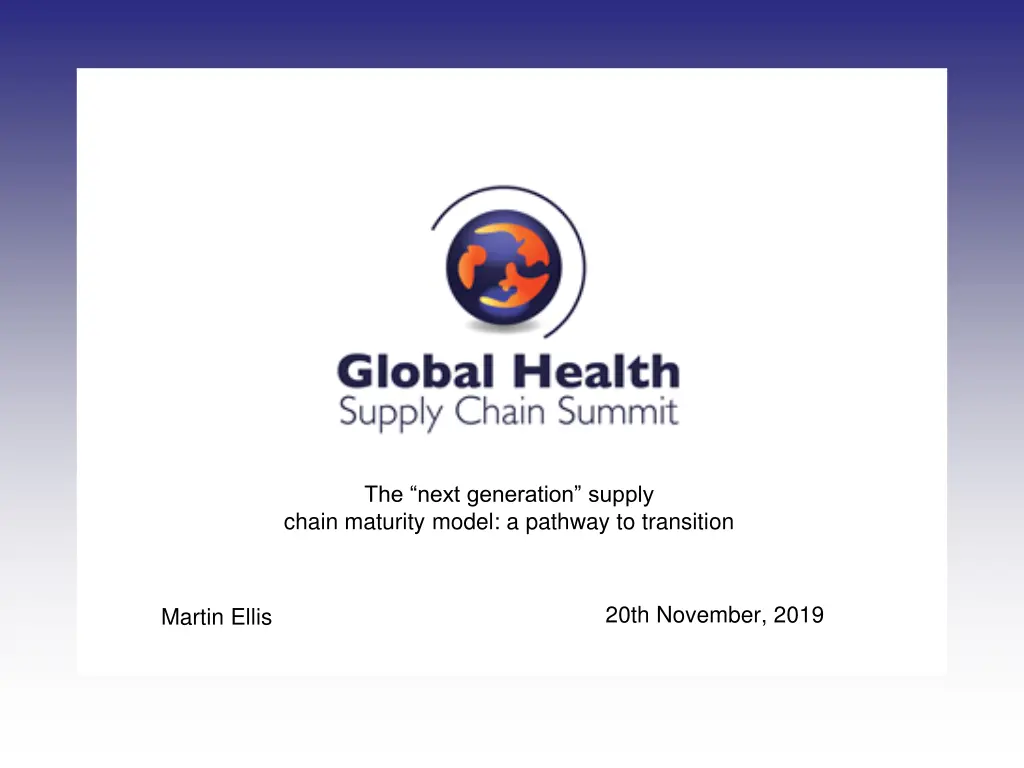
Next Generation Supply Chain Maturity Model & Foreign Aid Impact
Explore the Next Generation Supply Chain Maturity Model and the impact of foreign aid, including insights on motivating progress in global health initiatives. Gain a comprehensive understanding of supply chain evaluation and collaborative approaches for sustainable development.
Download Presentation

Please find below an Image/Link to download the presentation.
The content on the website is provided AS IS for your information and personal use only. It may not be sold, licensed, or shared on other websites without obtaining consent from the author. If you encounter any issues during the download, it is possible that the publisher has removed the file from their server.
You are allowed to download the files provided on this website for personal or commercial use, subject to the condition that they are used lawfully. All files are the property of their respective owners.
The content on the website is provided AS IS for your information and personal use only. It may not be sold, licensed, or shared on other websites without obtaining consent from the author.
E N D
Presentation Transcript
The next generation supply chain maturity model: a pathway to transition 20th November, 2019 Martin Ellis
The Next Generation Supply Chain Maturity Model: A Pathway to Transition Martin Ellis Optimised Operations Limited The Next Generation Supply Chain Maturity Model: A Pathway to Transition
The purpose of foreign aid is to end the need for its existence Mark Green (USAID Administrator)
Some context before we start - How to motivate people!! It should scare all of us that 15 years into PEPFAR we re talking about problems with the supply chain, because I can tell you, we ve invested about $3 billion to $4 billion in the supply chain, So clearly we have to be honest, there are certain things that didn t go well, and now we need to fix those, and we need to hold ourselves accountable, Deborah Birx, the United States global AIDS coordinator. at the Bipartisan Policy Center in Washington, D.C 13thDec 2017
$3 billion to $4 billion is not much when you consider what it has achieved! Globally, more than 21 million people were receiving lifesaving treatment at the end of 2017, up from 11 million in 2012. That s a 91% increase In sub-Saharan Africa, 14.6 million people were receiving lifesaving treatment at the end of 2017, up from 7.7 million in 2012. That s a 90% increase Globally, 1.8 million people became infected with HIV in 2017 down from 2 million in 2013. That s a 10% decrease In the last 15 years, the cost of antiretroviral treatment for one person has dropped from US$10,000 a year to US$75 a year an all-time low Source ..
Lets congratulate one another and motivate ourselves to do even more great things! Up 52% Down 39% Down 30% Down 64% Down 45% Up 3,945% Up 296% UNAIDS Factsheet Global Aids Update 2019
We need an integrated approach in supply chain maturity evaluation Traditional Independent Approaches Collaborative and Holistic Approach The Global Fund 7 Stage Supply Chain Diagnostic Common Assessment & Maturity Model Tool Common KPIs Common Method of Identifying the point of Transition Joints Assessments & Evaluation Integrated Health Systems Strengthening Planning Collaborative Projects Integrated Monitoring & Evaluation Transition Consensus USAID NSCA 2.0 BMGF Maturity Model
Evaluating the end to end supply chain means three flows require consideration Typical straight line view of the supply chain elements Procurement $ Port of entry Central warehouse Transport Regional warehouse Health Facility Financial flows Data gathering Forecasting DONOR DEMAND FLOW Forecasting & Procurement Inventory & Consumption People & Organisation Process & Policy Technology & Infrastructure Need Suppliers The Z Model view of the supply chain elements Payment Funding CASH FLOW People & Organisation People & Organisation Patients Process & Policy Technology & Infrastructure INSURANCE PROVIDER GOVERNMENT DONOR PATIENT
How do we determine when a country does not require continued funding for supply chains? True Transition = The point where a supply chain is operating at an adequate and sustainable level, and the country has the capability and funding to improve operations further Perfecti on Where is the point of TRANSITION? No further funding is required from Donors However, Transition should not be the end goal of the Country. Totally Dysfunct ional It is their responsibility to ensure there is continued improvement
The maturity matrix defines each levels criteria and further granular tables exist for each stage of the supply chain OVERARCHING HIGH LEVEL SUMMARY CANVAS BRONZE SILVER GOLD ACCREDITED GOVERNANCE Government controlled / Emerging private sector Government Operated / Donor Funded Government controlled / Private sector operated High level of Public- Private Partnerships (PPPs) in place Private Sector or PPP Operated / Competitive SOPs in place Seeking Accreditation Developed Country Standards (eg. ISO Accredited) PROCESS No documented processes Procedures exist for most processes Standard operating procedures in place Qualified supply chain experts with 1st degrees increasing Dedicated 1stdegree and masters level qualified supply chain staff Pharmacists trained in supply chain short courses PEOPLE No qualified supply chain staff Qualified supply chain staff Most functions supported by spreadsheets + basic bespoke software packages Effective use of forecasting software & warehouse managements systems (WHS) TECHNOLOGY Forecasting / Supply Planning / WHS & Barcoding in use Dedicated supply chain systems + Track & Trace Basic use of technology By standardising a maturity model framework (including KPI quantitative measures), a tool can be developed and used universally to determine improvements to lift maturity to the next level, and ultimately identify when a country has graduated requires no further aid!
There has to be an element of integration and consolidation to allow private sector to enter the market Graduated Silver CANVAS BRONZE SILVER GOLD ACCREDITED Private Sector Maturity Focal Zone Financier Donor & Aid Agency Maturity Focal Zone Health Product Supply Chains Operated MoH, Donors and Implementing Partners Emerging Integration & Consolidation of Health Product Supply Chain Operations MoH monitors and releases control to private sector operations Health Product Supply Chains Operated by Private Sector PPP s coordinated by Supply Chain Professionals working in the MoH Private Sector Ready There would still be work to be done to attain the Gold and Accredited levels, but at Silver, the country would have the skills and potential to improve their operations themselves There has to be an element of integration and consolidation of donor operations to allow private sector to enter the market A Graduated Silver country would be considered to be at a level of maturity that requires no further assistance. 12
Maturity improvement costs decease and benefits increase with each additional level achieved CANVAS BRONZE SILVER GOLD ACCREDITED Ease of Costs are very high in the initial levels of maturity due to capex requirements in infrastructure, facilities, equipment and IT, in addition to capacity building and process development Costs to improve reduce as infrastructure and process exists. The cost is then mainly attributed to the continued development of capacity and the seeking of accreditation Implementation Benefits are slow to come to fruition due to the time it takes to build the infrastructure and train the people With infrastructure in place and operated to standardised processes by highly qualified staff, costs, quality and delivery become optimised COSTS BENEFITS
All 9 functions / activities are evaluated and a maturity level individually determined for People, Process and Technology Procurement $ Port of entry Central warehouse Transport Regional warehouse Health Facility Financial flows Data gathering Forecasting 2 of 9 Sheets
A supply chain maturity map can then be presented which identifies the strong and weak areas Utilising an appropriate & standardised criteria for each element, the three dimensions can be graded either Canvas, Bronze, Silver, Gold or Accredited The illustrative table below shows an end to end supply chain which appears to predominantly Bronze, with some dimensions still at Canvas requiring improvement and some which are already at Silver People & Organisation includes: organisations structures, skillsets, qualifications, leadership and management. training, development, etc. Process & Policies includes: standard operating procedures, corporate strategy and policies, process flow, manuals, templates, etc Technology & Infrastructure includes: facilities, IT, equipment, tools, vehicles, warehouses, racking. temperature controls, software, etc Bronze Canvas Silver This country would be considered an Aggregated Bronze but NOT a Graduated Bronze as that would require all boxes to be a least at Bronze level.
From the maturity model & associated root cause analysis, an improvement programme can be developed to increase maturity to the next level Leadership & Governance PEOPLE I. Supply Chain Governance, Leadership & Performance Organisation Structure Development & Training C. Improve Data Gathering, Collation & Communication (LMIS) Strategy H. Improve Inventory Management & Control B. Improve Regional Warehouses PROCESS G. Health Centre Strengthening Process & Technology Review Policy & Regulation D. Improve Forecasting & Analytics A. Procurement Restructure Distribution Improvements F. Central Warehouse & Standard Operating Procedures IT (Hardware & Software) TECHNOLOGY Infrastructure E. Port Equipment
Each sub programme element should be defined and detailed using a Project Charter G Health Centre Strengthening Project Charter Workstream Recommendations. Opportunities & Challenges Summary Skills and experience in supply chain activities such as stock control, consumption recording the communication are needed by the development of well- defined roles and responsibilities for health facility store operations. In addition, suitably experienced (qualified if possible) staff should be Identified and trained in health facility store operations (standard operating procedures). There appears to be a general lack of resource in the public health system to monitor stock (Levels 3, 4 & 5) a review needs to identify the reasons / root causes of this. It is understood that there is some inaccessibility to health facility (Delivery). This may either require some consideration of infrastructure, or other methods of delivery such as by air (Aircraft or Drone). This could possibly help improvement in access of health commodities for the hinterland region. It was stated that facilities and equipment can be either in poor condition or not available with no cold storage at health facility. A review should be undertaken to understand the magnitude and significance of the situation. Even though some health centres are small it is still important that PODs are still signed by facilities and feedback. Approach Supply Chain Expert to work directly with the Health Centres to identify gaps in service and improvements. Develop a comprehensive plan including organisational and reporting structure and a full set of SOPs with training. Develop a CapEx Plan to include infrastructure and IT Resources 1 x Supply Chain Expert 9 months 1 x MoPH Health Centre Specialist 20% Time of Health Facility Staff Key Benefits Efficient Health Centre operations Transparency / Visibility of Inventory Higher inventory turns Improved availability of products, fewer emergency orders & expirations Costs Approximately $180K STTA + Expenses Workshop and Training Costs (including Per Diems) Does not include MoPH resource Does not include any IT solution costs Stakeholders Ministry of Public Health Ministry of Communities Regional District Administration Health Facilities Timing 2020 2019 F M A M J J A S O N D J F # MoPH # Advisors
Future progress of the Guy-SCIP should first focus on completion of the Procurement Project and formation of a Steering Board 2019 2020 Supply Chain Maturity Improvement Program Timing M J J A S O N D J F M A M J J A S O N D A Procurement Restructuring Supply Chain Governance, Leadership & Performance I Improve Data Gathering, Collation & Communication C Improve Forecasting & Analytics D Improve Inventory Management & Control H Port Process & Technology Review E Central Warehouse & Distribution Improvements F B Improve Regional Warehouses G Health Centre Strengthening
Usually executive accountability rests with a Steering Board which is responsible to the Country and funding Partners Typically a Steering Board would meet quarterly. This could be monthly to start with to ensure a smooth and orderly start to the programme Steering Board Chair Perm Sec Donor/s MoH Officers Core Group Lead Facilitator / Adviser Core Group The Core Group would manage the Project Teams on a monthly basis Core Group Lead Facilitator / Adviser MoH SC Dep t Heads Project Team leads The Project Teams would be responsible to undertake the daily activities and report progress and any challenges or barrier encountered
Every partner at all stages of the supply chain will benefit from a common understanding of supply chain maturity Financier Donors (More effective use of funds and resources) Government Agencies (More effective use of funds and resources, facilities and technology) National Governments (Better understanding of supply issues, what they are and how to sustainably fix them) NGOs and Implementing Partners (Better understanding of required skillsets and where resources should be deployed) Private Sector (Fuller understand how Private Sector can be engaged - when, where and how) Suppliers (Better aggregated forecasts - more certainty of quantity requirements and more accurate lead time notice)
Conclusion Through collaboration within the health product supply chain community, the next generation maturity models can be made to be: Standardised Visual and Transparent Easy to understand Able to compare and contrast different country s overall and elemental maturity levels to better understand if common solutions and approaches exist Capable of generating workplans to take a country from one level of maturity to the next, and... Ultimately give the confirmatory knowledge of when aid is required and when it is not!

